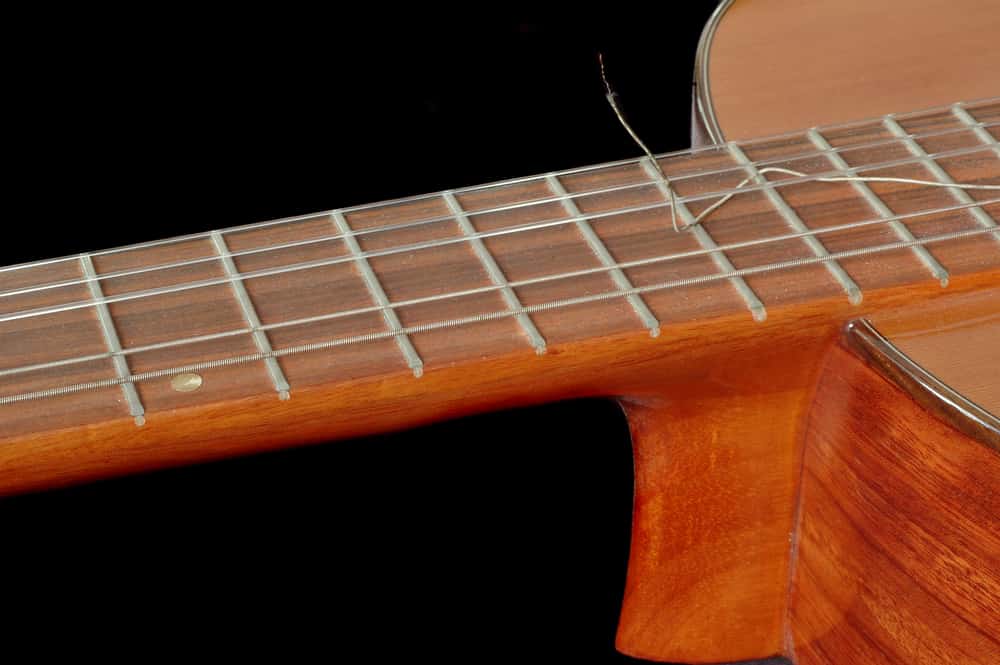I love playing classical guitar because I enjoy the soothing and soft sound of the nylon strings. I only get to play a few hours every few weeks or so, but they are beautiful sounding instruments. That being said, I always keep a bundle of unpacked new strings for replacement when it is time to change the strings. With the experience of using classical guitars for almost a decade, I have learned many things about changing the strings and how often you should do so.
On average, you should change your classical guitar strings after every 90 days or about 100 hours played. This is suitable for hobbyists who are not playing professionally. Professional classical guitar players should change their strings far more frequently, weekly or even daily, in order to maintain optimal sound quality.
Classical guitar strings wear out with time and from hours played. You will notice that the strings will lose their sharpness over time and become dull sounding. Replacing old strings is an easy and quick way to achieve a better and brighter tone.
Over the years, I have tested a variety of different pieces of advice that I have received concerning classical guitar strings. Read on to learn about changing classical guitar strings; how often, why, and when, answers to related questions, and a video on changing the strings.
How Long Do Classical Guitar Strings Last
Classical guitar strings have a lifespan. Whether used or not, they will get worn by the elements and lose clarity once they are out of the pack.
How long the strings will last will also depend on how you care for the strings, and the number of hours played. If you are a regular player who doesn’t miss a day without touching the strings, then you should expect them to last for a shorter amount of time than if you were only playing once or twice a week.
Poor handling of the strings can also make them break, and when they do, you have to throw them out. Therefore, there is no specific timeline. The lifespan will depend on the following factors:
- The number of times you play your guitar.
- Handling and maintenance of the strings.
- How you store your guitar.
When To Change Classical Guitar Strings
There are a few indicators that you should be aware of which will tell you when it’s time to change your classical guitar strings.
When your guitar strings begin to lose their tone or produce a dull sound, then it is time to change them. You will notice that your string sounds flat and weak compared to what it sounded like fresh out of the pack.
The change in tone is often the most obvious indicator, but here are a few more:
- A lot of grime in the strings.
- When the strings become stiff.
- When the strings become difficult to tune.
- When the strings produce a weak and flat or dull sound.
- When any of the guitar strings break.
- When the recommended time to change has elapsed.
Therefore, you should observe the schedule below for a better sound in your classical guitar.
| Guitar player | When to change the strings |
| Touring concert guitarists | Every 10 hours/daily |
| Professionals | Every 50 hours/weekly |
| Consistent players | Every 100 hours/ monthly |
| Consistent learners | Every 100 hours/monthly |
| Novice players/beginners | Every 200 hours/6 months |
| Once in a while player | Every 200 hours or annually. |
From the above table, it is evident that the more you play the guitar, the more often you will need to replace or change the strings.
Check out this video on replacing classical guitar strings:
Number Of Classical Guitar Strings
Most classical guitars have 6 strings from the highest pitch to the lowest pitch. The thinnest is the first string and the thickest is the sixth string. The strings are made of nylon. The first three strings produce a high-pitched tone and are composed of a single, nylon string. The last three strings produce a base tone and consist of several hundred individual strands of nylon wrapped with silver and copper thread. The last three are easily identifiable because they have a silver color to them.
A pack of guitar strings on the market normally comes with six strings. These strings serve as a replacement for all the strings of a classical guitar. However, some models have 7, 8, or even more strings.
Nylon Strings on Classical Guitars
A common question for many beginner classical guitarists is whether or not they have to buy nylon strings for their classical guitar. Do not use steel strings on your classical guitar. Classical guitars do not have truss rods that work to protect the neck of the guitars from the high tension of the steel strings. The tension from nylon strings is far less than that of a steel string, approximately 50% of the tension of a steel string.
Steel strings are very typical for acoustic and electric guitars. When steel strings are used on the classical guitar, the high tension of the strings can alter the neck angle of the guitar, pry the bridge away from the soundboard or damage the tuners.
Another issue with steel strings is that they produce an entirely different sound than nylon strings. Nylon strings have a soft and mellow tone, whereas steel strings produce a harder and brighter tone.
One major benefit of nylon over steel strings is that nylon is much softer and more gentle on a beginner’s fingers. Steel strings tend to cause severe discomfort in beginners, at least until their calluses build up on their fingertips.
What are the Best Classical Guitar Strings?
There are lots of different classical guitar strings available on the market. One factor that will go into how frequently you need to replace your strings is the quality of string that you are using. By far, my favorite, and probably most recommended by most people are the D’Addario Pro-Arte nylon guitar strings. These strings are known to be extremely durable, last longer than many other brands, and are one of the best sounding strings on the marketplace.
- STANDARD CLASSICAL TONE - Pro -Arte’ Nylon strings offer the standard classical guitar tone many players hold dear.
- RESPONSIVE PLAYABILITY & WARM TONE - Utilizing our multi-filament nylon core basses and clear nylon trebles, Pro-Arte’ Nylon strings provide beautifully responsive playability and sweet, mellow tonal warmth.
- TIE ENDS - This set features tie-ends, nylon monofilament material, and silver-plated copper wrap wire.
- EARN REWARD POINTS - D’Addario Pro-Arte’ Nylon classical guitar strings come with a code on the recyclable, resealable VCI bag, which you can register to earn Players Circle points.
- MADE IN THE USA – Our classical strings are made in the USA—drawn to exacting specifications at our New York production facility.
Other extremely popular options for classical guitar players include:
- LaBella 900
- LaBella 820. These are popular among Flamenco players.
- Savarez Corum
Lifespan Of Unused Classical Guitar Strings
If you have installed your guitar strings but have not played them, you might be wondering how long the strings will last just sitting on your guitar. If not played, classical guitar strings can last for up to 12 months or more. This is partially dependent on environmental factors, such as humidity.
The best rule of thumb here is that if you don’t plan on playing your guitar any time soon, don’t take your strings out of the package. Your strings will last a lot longer if they are stored in their packaging instead of installed on your guitar and sitting in your case.
What Happens If You Don’t Change Guitar Strings?

Maybe you’re the type of player that likes to get every last bit of life out of your guitar strings. That is okay, if you’re still happy with the sound then you don’t have to necessarily change your strings. Your strings will not damage the fretboard if you keep them past their normal life, but they will have a significantly dulled-down sound, the strings will feel stiff and grimy, and they will become discolored.
One nice thing about the nylon strings is that you don’t have to worry about the strings breaking and whipping your face as you do with steel strings. It’s not that nylon strings don’t break from time to time, they do, but nylon is significantly softer than steel, and nylon strings are under significantly less tension than steel strings.
Final thoughts
I hope you have learned something from this guide on how often you should replace or change your guitar strings. It all depends on the usage and the purpose of your classical guitar. If you are a touring professional, you may need to change more often than if you are just a beginner or you play your guitar once in a while.

